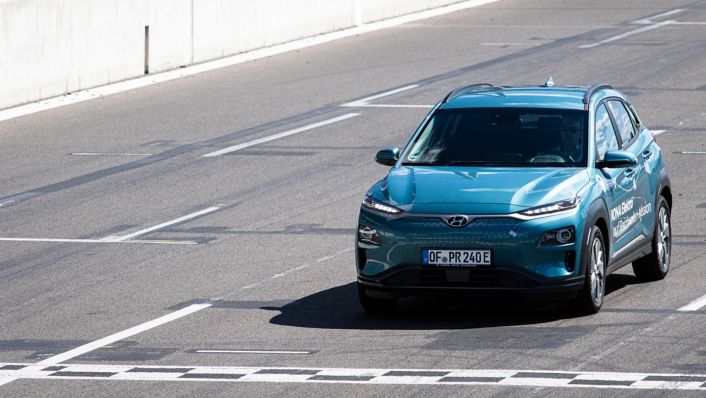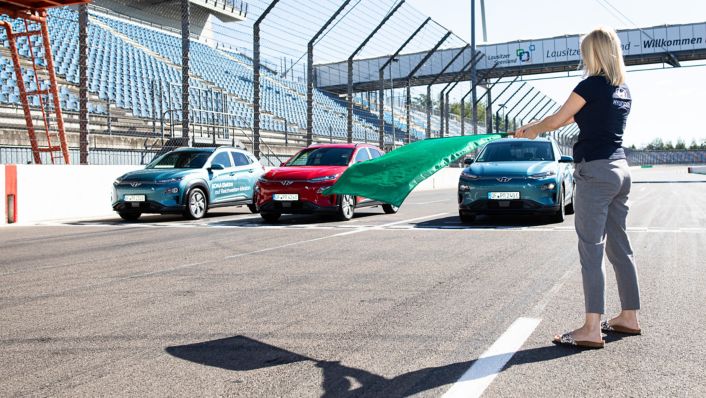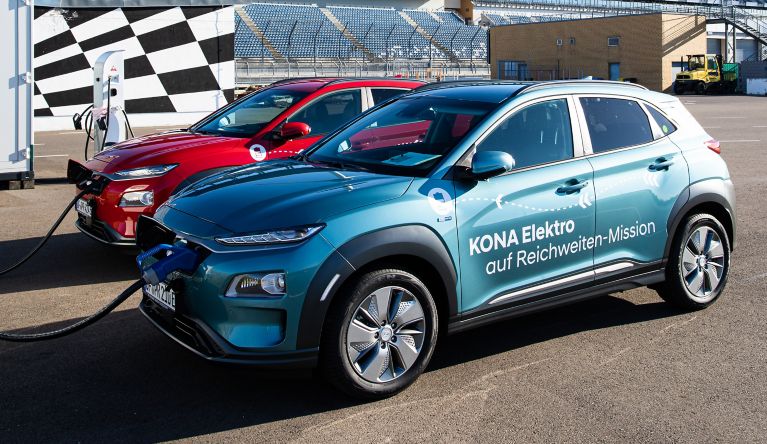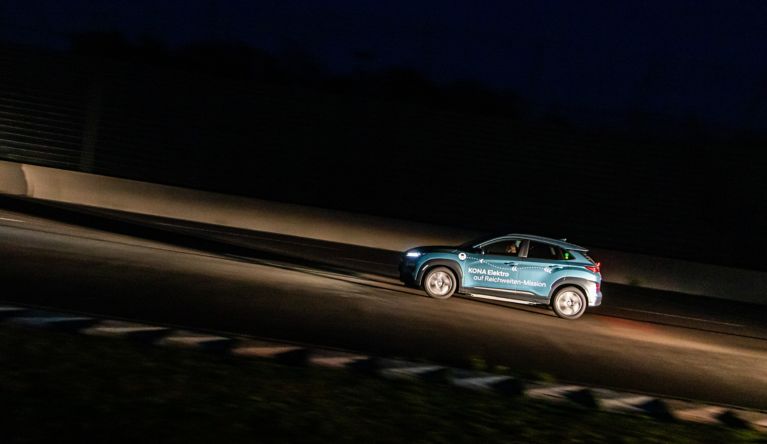- Three series production subcompact SUVs tested at the Lausitzring race track
- All Kona Electric models confidently exceeded the 1,000-kilometre mark
- Range record provides valuable findings for day-to-day use of the vehicles
Press material
-
Download
-
Images
The challenge was simple: with a single battery charge, each car should be able to go further than 1,000 kilometres. The fully-electric subcompact SUVs mastered the test, also known as “hypermiling”, with ease and only stopped without power after exactly 1,018.7, 1,024.1 and 1,026.0 kilometres. In relation to the 64 kWh battery capacity, each individual value represents another record, as the cars' power consumption of 6.28, 6.25 and 6.24 kWh/100 km was well below the standard value of 14.7 kWh/100 km determined by the WLTP.

All Kona Electric vehicles were in series production when they arrived at the Lausitzring, which corresponds to a range of 484 kilometres according to the WLTP standard. In addition, the three 150 KW/204 PS city SUVs were controlled by alternating drivers during their three-day deployment, and the vehicles' assistance systems remained untouched. These two factors are also important prerequisites for the significance of Hyundai’s range mission. Dekra, the expert organisation that has been operating the Lausitzring since 2017, ensured that everything went according to plan during the successful efficiency record attempt. Dekra engineers made sure that everything went smoothly by monitoring the vehicles used and keeping a record of each of the 36 driver changes.

Energy saving driving as a challenge
Since no other volume brand manufacturer has ever undertaken such a practical test, the advance estimates were correspondingly cautious. The Hyundai technicians working with Thilo Klemm, Head of Aftersales Training Centre, had calculated a theoretical range of between 984 and 1,066 kilometres for a simulated drive at the average speed of inner-city traffic. This was a challenge for the teams, because driving in an energy-saving manner required concentration and patience in the summer weather.

Three teams competed against each other at the Lausitzring: a team of test drivers from the renowned trade magazine Auto Bild, one with technicians from Hyundai Motor Deutschland’s after-sales department and another team consisting of members of the company’s press office and product marketing department. Although the use of air conditioning was not prohibited, none of the teams wanted to take the risk that an air-conditioned drive with an outside temperature of up to 29 degrees Celsius might have melted away crucial kilometres of range. For the same reason, the Kona Electric’s entertainment system remained switched off throughout, with available power used solely for propulsion. Only the daytime driving light remained switched on, in order to comply with the legal requirements for road traffic. The standard Nexen Nfera SU1 low rolling resistance tyres in the 215/55R17 size were used as tyres.
The average speed of the teams after the over-1,000 kilometre distance was between 29 and 31 km/h. Although this may sound slow at first glance, it had to be achieved in typical inner-city traffic conditions, including rush hour and traffic light changes, as well as in the 30 km/h zones of residential areas.
With this test, the Kona Electric demonstrated its potential as an efficient and environmentally-friendly lifestyle SUV. This proves its suitability for everyday use and shows that, when it comes to our electric vehicles, range anxiety should be a thing of the past.
An extremely reliable charge level indicator
On the evening before the record rides, the conditions of all three Kona Electric models were checked and weighed by Dekra engineers. In addition, the experts compared the odometres and sealed the interface of the onboard diagnostics, as well as the safety flap under the dashboard and over the loading flap in the front bumper, to rule out any manipulation of the result. Then the almost-35-hour journey began. The Hyundai electric fleet then carefully drove along, whisper-quietly. Things got lively during the driver changes, when topics such as the cruise control settings, the current fuel consumption display of the on-board computer and the best, i.e. most efficient way to approach the banked curves of the 3.2-kilometer-long tri-oval, were discussed.

In the early afternoon of the third day, the first warnings from the EVs appeared on the display. If the capacity of the batteries fell to below eight per cent, the Hyundai Kona Electric's on-board computer recommended that the vehicle should be switched to a power source. If the remaining capacity of the battery dropped to only three per cent, they would switch to emergency mode, with a reduction in full engine power. However, this did not appear to affect the drivers, and with three per cent residual capacity, the vehicles still managed to cover more than 20 kilometres on their efficiency drive.
Customers are convinced about Kona Electric
The range mission showed us that the Kona Electric's high-voltage batteries and power electronics harmonise very well. It is also significant that all three test cars achieved almost the same number of kilometres. This represents an extremely low production spread.
Another important finding during the test was that the charge level indicator of the Hyundai Kona Electric is very reliable and counts down percentages according to driving style. At zero per cent, the car continues to drive for several hundred metres, then drives out without power and finally stops with a small jerk because the electric parking brake is activated for safety reasons.

I offer my congratulations to all who took part in this range mission, which has proven that our Kona Electric is affordable, immediately available and highly efficient. This lifestyle-oriented car combines the attractive design of a compact SUV with the advantages of an environmentally-friendly electric vehicle. That means every Kona Electric customer will purchase a vehicle with a range of sophisticated technology that remains suitable for everyday use.

Hyundai Kona Electric is Hyundai’s top selling BEV in Europe
The result is supported by the expansion of Kona Electric's production at the Hyundai Motor Manufacturing Czech (HMMC) plant in Nošovice, Czech Republic. HMMC has manufactured the battery electric version of the lifestyle SUV since March 2020. This enables Hyundai to significantly reduce waiting times for new electric cars. And this already was rewarded by the customers. With almost 25.000 units sold so far in 2020, it belongs to the best sold fully-electric models and is the best sold battery electric SUV in Europe.

















